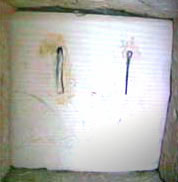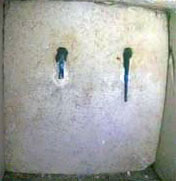|
Update: Third "Door" Found in Great Pyramid
National Geographic News
Scientists exploring the Great Pyramid in Egypt sent a robot into the
northern shaft in the past few days, discovering another blocking stone. The
"door" appears to be identical to the one in the southern shaft that was
already known. The doors are equidistant (65 meters/208 feet) from the
queen's chamber. It is the third such block discovered within the shafts of
the pyramid.
A specially developed combination of robotics, camera, and lighting technology developed by iRobot of Boston, yielded the new information.
Until this discovery, no one knew that the northern shaft extended to the north as far as the southern shaft goes to the south.
Prior explorations of the northern shaft have failed because, unlike the southern shaft, the northern shaft has a number of bends and sharp corners. Hawass suggested that the layout of the northern shaft may have been designed to avoid intersection with the pyramid's grand gallery.
The newly discovered northern shaft door appears to be very similar to the one in the southern shaft, including the presence of a pair of copper "pins" or "handles." The southern shaft "door" was discovered in a 1993 investigation conducted under the auspices of the German Archaeological Institute.
On September 17, 2002, a National Geographic robot, specially designed to traverse the southern shaft to the blocking stone, inserted a miniature fiber-optic camera into a three-quarters-of-an-inch hole to reveal the rough-hewn blocking stone lying seven inches beyond the original southern shaft door. That earlier portion of the expedition was broadcast live in an international television event carried on National Geographic Channel and on Fox in the U.S.
Portions of the northern shaft have been previously explored. In 1872
Waynman Dixon found a small bronze hook and granite ball. In the 1920s a
pyramid enthusiast, Morton Edgar, attempted to learn more about the queen's
chamber shafts by using flexible metal rods. In the southern shaft he was
stopped, presumably by the blocking door. In the northern shaft, which
appears to bend and curve around the grand gallery, Edgar's flexible rods
broke and remain there to this day. The SCA/NG robot "rover" had to navigate
around the metal rods to reach the end of the northern shaft.
|

